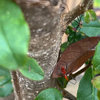How do we feel about dipel dust?
Mindyw3
12 years ago
Related Stories

HEALTHY HOMEWhat to Know About Controlling Dust During Remodeling
You can't eliminate dust during construction, but there are ways to contain and remove as much of it as possible
Full Story
HEALTHY HOMEWhat You Need to Know About Dust and How to Fight It
Breathe easier with these 10 tips for busting mites, dander and other microscopic undesirables
Full Story
FUN HOUZZArt House on the Edge Makes a Statement About ‘Place’
Gravity-defying installation in San Diego features a cottage dangling from a university roof, challenging the notion of home
Full Story
LIFEHouzz Call: What Has Mom Taught You About Making a Home?
Whether your mother taught you to cook and clean or how to order takeout and let messes be, we'd like to hear about it
Full Story
FURNITUREHow to Buy a Quality Sofa That Will Last
Learn about foam versus feathers, seat depth, springs, fabric and more for a couch that will work for years to come
Full Story
DECORATING GUIDESHouzz Tour: Much to Like About This Traditional Beauty
New elements mix well with old in a New Jersey family’s elegant and comfortable colonial revival home
Full Story
DECORATING GUIDESExpert Talk: Designers Open Up About Closet Doors
Closet doors are often an afterthought, but these pros show how they can enrich a home's interior design
Full Story
ARCHITECTUREThe Truth About 'Simple' Modern Details
They may look less costly and easier to create, but modern reveals, slab doors and more require an exacting hand
Full Story
GREAT HOME PROJECTSWhat to Know About Adding a Reclaimed-Wood Wall
Here’s advice on where to put it, how to find and select wood, what it might cost and how to get it done
Full Story
LIFEThe Beautiful Thing About Dad's Chair
My father had his own spot in the house. His father had his own spot. Now I have mine
Full Story








jean001a
Mindyw3Original Author
Related Professionals
Simpsonville Landscape Architects & Landscape Designers · Graham Landscape Architects & Landscape Designers · River Forest Landscape Architects & Landscape Designers · Wilmington Landscape Contractors · Americus Landscape Contractors · Dixon Landscape Contractors · Maywood Landscape Contractors · Tustin Landscape Contractors · Baltimore Decks, Patios & Outdoor Enclosures · Garden City Decks, Patios & Outdoor Enclosures · Knoxville Decks, Patios & Outdoor Enclosures · Palmetto Decks, Patios & Outdoor Enclosures · Richmond Decks, Patios & Outdoor Enclosures · Riverside Decks, Patios & Outdoor Enclosures · South Milwaukee Decks, Patios & Outdoor Enclosuresrhizo_1 (North AL) zone 7
feijoas
Kimmsr
Me112233
rhizo_1 (North AL) zone 7